Basic Concepts
We introduce and define the most basic concepts of Prolog.
Terms
In Prolog, all data—including
Prolog programs—are represented by
Prolog terms.
Programs
A Prolog program is a set of predicates.
Predicates define relations between their
arguments. Logically, a Prolog program states what holds.
There are a few conventions
for writing Prolog programs, and
different ways of reading them.
Predicates
Each predicate has a name, and zero or
more arguments. The predicate name is a
Prolog atom. Each argument is an arbitrary
Prolog term.
A predicate with name Pred and N arguments is
denoted by Pred/N, which is called
a predicate indicator. N is called
the arity of the predicate.
| Video: |
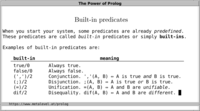
|
A predicate is defined by a collection of clauses.
A clause is either a rule or a fact. The
clauses that constitute a predicate denote
logical alternatives: If any clause is true, then
the whole predicate is true.
| Video: |
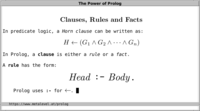
|
Rules
A Prolog rule has the form:
Head :- Body.
The notation of the head of a rule depends on the number of
arguments:
- If the predicate has zero
arguments, then the head consists only of the predicate name.
- If a predicate called Name has a positive
number N of arguments, then the head is written
as:
Name(Arg1, Arg2, ..., ArgN).
The body of each rule is a Prolog goal.
A goal is a Prolog term that denotes a predicate and its arguments.
A rule is called recursive if one of its goals refers to
the predicate that the rule is defining.
Facts
A fact is written as:
Head.
This is equivalent to the rule:
Head :- true.
Logically, this means that the rule always holds,
because the built-in
predicate true/0 is always true.
Toplevel
The Prolog toplevel is the main way in which we run
Prolog programs.
| Video: |
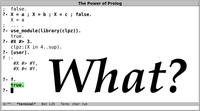
|
We invoke a Prolog predicate by posting a query on the
toplevel. A query is an arbitrary Prolog goal. In a
query, variables are existentially quantified. We can thus
read a query as: "Are there any cases for which the given
predicate holds?"
| Video: |
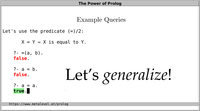
|
In response to a query, the toplevel reports an answer.
The answer is a Prolog goal that is
declaratively equivalent to the query.
Every predicate has an associated most general query, which
means that all arguments are fresh variables.
Note that a goal can succeed more than once. Depending on
your Prolog implementation, you either press SPACE
or ";" to see alternatives.
Running Prolog code
Running a Prolog program can be regarded as a special case
of resolution, which is an algorithm that is rooted in
formal logic. Logically, when Prolog answers a query, it
tries to find a resolution refutation of the negated
query and the set of clauses that constitute the program. When a
refutation is found, it means that the query is a
logical consequence of the program.
An important step in this process is syntactic unification
of terms. Unification is a generalization of pattern
matching. When a clause head is chosen for unification with a
Prolog goal, then unification applies to the arguments
of both.
For this reason, there is no distinction between input and
output arguments of pure predicates, and
Prolog predicates can often be used in several directions.
If multiple clause heads unify with a goal, then alternatives are
tried on backtracking.
Informally, you can think of Prolog's default execution strategy,
which is called depth-first search with chronological
backtracking, as a generalization
of function calls that are available in other
languages. The main differences are that: (1) multiple
clauses can match and (2) unification works in both
directions.
A Prolog program can be interpreted with different
execution strategies that can be flexibly
selected. SLG resolution
is an alternative execution strategy that is available in an
increasing number of Prolog systems. The ability to use
different execution strategies while keeping the program unchanged
is a major attraction of Prolog.
To find mistakes in Prolog programs,
it is typically not necessary to trace the actual execution
steps. Instead, declarative
debugging techniques can be applied to narrow down
mistakes by logical reasoning.
Built-ins
Some predicates are already predefined when you start your
Prolog system. These are
called built-in predicates or
simply built-ins.
For example, the built-in (=)/2 is true iff its
arguments unify. The built-in true/0 is
always true, and the built-in false/0 is
always false.
Many built-ins are only available for convenience, and you
could easily define them yourself by the mechanisms explained
above. For example, if they were not already defined, you could
define the mentioned predicates as:
T = T.
true.
false :- a = b.
However, not all built-ins can be defined in this way.
In addition to (=)/2, true/0
and false/0, the most important built-ins you need to
know to write useful and pure Prolog programs are:
- dif/2 is true iff its arguments are different terms
- integer constraints let you reason about arithmetic expressions
- (',')/2 denotes conjunction: (A,B) is true iff both A and B are true
- (';')/2 denotes disjunction: (A;B) is true iff either A or B or both are true.
Example: Collatz conjecture
We illustrate all these concepts by means of an example:
Take any positive integer N. To get the next integer,
do the following:
- If N is even, divide it by 2.
- If N is odd, multiply it by 3 and add 1,
obtaining 3×N + 1.
Repeat this indefinitely to obtain the hailstone
sequence N0, N1, N2, ...
The Collatz
conjecture is that the integer 1 appears in
this sequence for all positive initial integers.
We can model the hailstone sequence as follows, using the
built-in integer
constraint (#=)/2 to denote equality
of two integer expressions:
hailstone(N, N).
hailstone(N0, N) :-
N0 #= 2*N1,
hailstone(N1, N).
hailstone(N0, N) :-
N0 #= 2*_ + 1,
N1 #= 3*N0 + 1,
hailstone(N1, N).
The predicate hailstone/2 is defined by
three clauses: one fact and two rules. It
defines a relation between two arguments. The first
argument represents the current element of the sequence. The
second argument is used to report solutions. After a query
is posted and an answer is reported by the toplevel,
the alternatives are tried on backtracking:
?- hailstone(3, N).
N = 3
; N = 10
; N = 5
; N = 16
; N = 8
; N = 4
; N = 2
; N = 1
; N = 4
; N = 2
; N = 1
; ... .
This program illustrates that a sequence of actions can be modeled
as a relation between successive states.
See Thinking in States for more examples.
As is characteristic for pure relations, the predicate can be used
in all directions. For example, we can post the most
general query:
?- hailstone(X, Y).
X = Y
; clpz:(2*Y#=X)
; clpz:(2*Y#=_A), clpz:(2*_A#=X)
; clpz:(2*_A#=X), clpz:(2*Y#=_B), clpz:(2*_B#=_A)
; ... .
When studying a Prolog predicate, try the most general query to see
what answers look like in general.
We can implement hailstone/2 more efficiently
with if_/3.
| Video: |
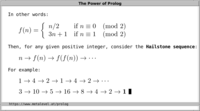
|
More about Prolog
Main page





